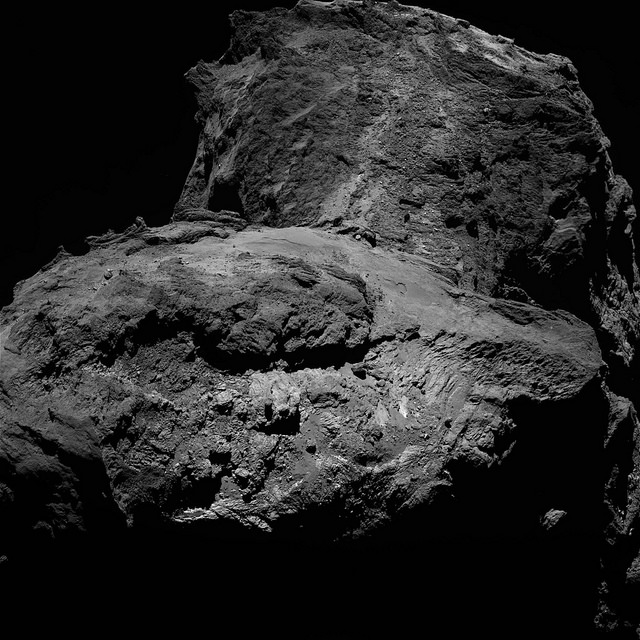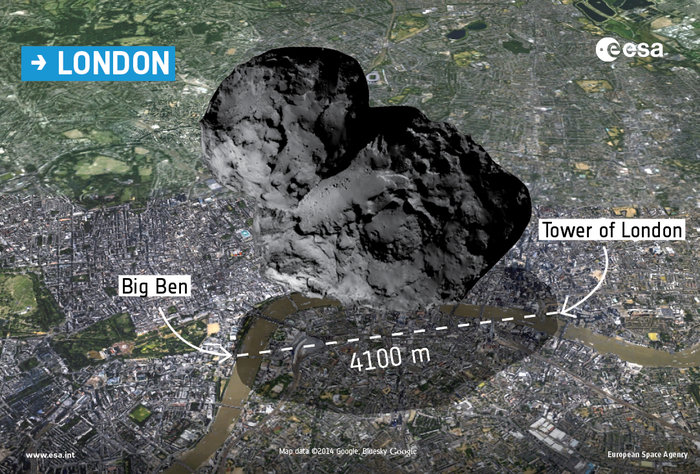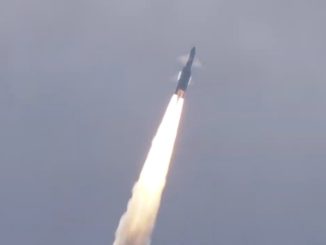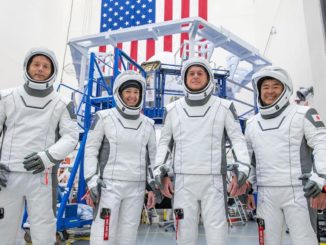
Entering the final months of a 12-year mission, Europe’s Rosetta spacecraft is again moving closer to the oddball comet that has engaged scientists since it arrived in 2014, heading for a controlled “smash” landing on the comet’s rugged charcoal-colored surface at the end of September.
Between now and then, scientists plan to steer Rosetta on trajectories as close as as a few kilometers from comet 67P/Churyumov-Gerasimenko, guide the probe on an excursion into the comet’s tail, and the complete the mission’s most detailed maps of the tiny tortured world.
The mission is tentatively scheduled to end the last week of September — there is some leeway to go a few weeks later — with a landing on the comet, where Rosetta will join its companion Philae on the surface.
“The next few months are probably the most intense the mission has ever seen,” said Matt Taylor, Rosetta’s project scientist at the European Space Agency, in an interview with Spaceflight Now.
Navigating a spacecraft near such an unconventional space object has not been easy. Navigators must take into account the comet’s chaotic shape and 12.4-hour rotation, and ground controllers threw out the playbook last year as jets of dust and vapor shot out of the nucleus, putting Rosetta in danger.
Rosetta backed away from comet 67P as it closed in on perihelion, the closest point of the comet’s orbit to the sun, and solar heating activated small eruptions of gas and dust particles into a cloud surrounding the comet’s nucleus.
The craft’s star trackers, which use stellar positions to compute the probe’s orientation, confused the tiny particles for stars, causing Rosetta to lose its antenna pointing lock on Earth during a close approach to the comet in March 2015.
The star tracker cameras functioned properly, ESA officials said, but the cloudy haze surrounding comet 67P proved more disruptive than predicted.
Ground controllers responded by keeping Rosetta’s distance from the comet, guiding the probe clear of the hazardous dust and gas populating the region closest to its core, or nucleus.
Comet 67P reached perihelion in August, and the comet’s activity is dissipating as it heads for the coldest segment of its six-and-a-half year circuit around the sun.
The waning warmth as Rosetta and the comet speed farther from the sun allows the spacecraft to move closer to the nucleus than it has since early 2015.

“We go as close as we can until the star trackers start to say we can’t track as well,” Taylor said. “We’re on the edge of the capability of the spacecraft. We can’t say where we’ll be. We’re just going as close as possible.”
Rosetta has moved as close as 32 kilometers (20 miles) in recent weeks, and the spacecraft will soon venture even closer.
In April, ground controllers will command Rosetta to veer away from the comet and head for its tail.
Rosetta will travel up to 1,000 kilometers (620 miles) from comet 67P some time in April, Taylor said, to examine how the solar wind — a stream of radiation emitted from the sun at more than 400 kilometers per second, or a million mph — interacts with the comet in space.
The spacecraft traveled about 1,500 kilometers (930 miles) from the comet in the direction of the sun last year to investigate the solar wind plasma conditions on the day side of the nucleus.
“It’s a different environment on the back side of the comet,” Taylor said. “We’ll be in the tail for about a week.”
Rosetta has been traveling around the comet in “pyramid-shaped” trajectories around the comet, but the craft will again move into “bound” orbits around the nucleus later this year.
Taylor said the comet is calming down as expected after perihelion, with current activity about equal to what Rosetta saw in March 2015, when it ran into navigation difficulties close to the nucleus.
Another priority for Rosetta’s science team is the collection of data for comparative studies to see how the comet’s landscape, composition and other characteristics may differ before and after the brush close to the sun.
“Doing the before and after look at the comet is one of the most important things,” Taylor said. “We’re trying to see some stuff we didn’t see (before perihelion) due to the star tracker issues.”

Rosetta and comet 67P are currently 362 million kilometers (225 million miles) from the sun, nearly twice the distance at perihelion six months ago.
“What’s changed? What’s different? The science we get after (perihelion) is going to be phenomenal,” Taylor said.
Scientists want to know where comet 67P originated, and the answer could shed light on the violent dynamics of the early solar system, when clumps of rock and ice regularly crashed into each other to construct the planets.
Comets and asteroids are the leftover building blocks of the solar system, and researchers believe studying such objects could help untangle how water, and potentially the organic constituents of life, spread to the planets.
Taylor said Rosetta continues to look for the signature of complex amino acids, which merge to form proteins.
Recent results from Rosetta include confirmation that comet 67P’s interior is fairly uniform and free of large internal caverns, leading scientists to conclude the ultra-low density of the nucleus must be due to the properties of the fine dust and ice that make up the comet.
Comet 67P formed from the soft collision of two smaller bodies, giving the nucleus its distinctive “rubber duck” shape.
Scientists said an infrared instrument aboard Rosetta also detected outcrops of water ice on comet 67P’s surface, which is mostly blanketed with a dark, gray coating of organic-rich material. Plumes of water vapor erupting from the comet originate underground, where researchers believe much more ice is present.
Rosetta’s pioneering mission, which began with its launch in March 2004, is nearing an end as the probe and comet head into the outer solar system, where they will eventually pass beyond the orbit of Jupiter. The faint sunlight at such distances is not sufficient to keep the spacecraft’s batteries charged.
Ground controllers will also be unable to communicate with Rosetta in October as it passes through the same part of the sky as the sun, and the spacecraft’s fuel tanks are running low.
The end game for Rosetta is to guide the probe to a relatively soft touchdown on comet 67P.

“The science team wants to put it near Philae,” Taylor said. “We don’t know if that fits with the end of mission scenario.”
Ferried to comet 67P by Rosetta, the Philae lander ended up lodged against a cliff on the small lobe of the comet after bouncing across the nucleus during its descent on Nov. 12, 2014. Starved of sunlight, Philae went into hibernation about two-and-a-half days later.
Engineers hoped to operate Philae for weeks, and the lander aimed for a relatively flat region in full sunlight. But failures of a thruster, anchoring harpoons and ice screws caused the dishwasher-sized to bounce off the comet despite an on-target descent.
The tiny world’s tenuous gravitational pull barely kept Philae from flying back into space, and the landing probe tumbled across the comet, striking its surface four times before settling in its final resting place more than a kilometer (3,300 feet) away from its original aim point two hours later.
But in an astonishingly dramatic twist, Philae survived the rough ride and radioed ground controllers the first-ever measurements from a comet’s surface, including a panoramic photo.
ESA officials said Philae, a mission led by Germany with significant contributions from France and other European research institutions, completed 80 percent of its planned science observations in the 64 hours it functioned from separation from Rosetta until the probe went to sleep.
Philae emerged from a half-year snooze as comet 67P moved into warmer conditions last year, and engineers received signals from the lander again on June 13. The probe radioed contacted Earth through a communications relay on the Rosetta mothership seven more times through July 9.
Then Philae fell silent again, and ground controllers have not heard from the spacecraft in more than seven months.
With temperatures on the comet falling again, the chances of another contact with Philae are extremely remote, officials said.

“The chances for Philae to contact our team at our lander control center are unfortunately getting close to zero,” said Stephan Ulamec, Philae project manager at the German Aerospace Center, DLR. “We are not sending commands any more and it would be very surprising if we were to receive a signal again.”
Efforts to establish a stable link with Philae last year were complicated by Rosetta’s distance from the comet, necessitated by the treacherous conditions close to the nucleus.
Rosetta is now flying back toward the comet, but engineers say temperatures inside Philae’s sensitive electronics are plummeting.
“We would be very surprised to hear from Philae again after so long, but we will keep Rosetta’s listening channel on until it is no longer possible due to power constraints as we move ever further from the sun towards the end of the mission,” said Patrick Martin, ESA’s Rosetta mission manager.
Engineers blame failures in the lander’s radio transmitters and receivers for the intermittent contacts in mid-2015.
“Philae has been a tremendous challenge and for the lander teams to have achieved the science results that they have in the unexpected and difficult circumstances is something we can all be proud of,” Martin said. “The combined achievements of Rosetta and Philae, rendezvousing with and landing on a comet, are historic high points in space exploration.”
In addition to the high-priority science observations over Rosetta’s final months, the orbiter will try to pinpoint Philae’s location with high-resolution imagery as engineers lower its altitude.
Analysts narrowed Philae’s location to an ellipse nearly twice as long as a football field, but its exact position is still unconfirmed.
An image of Philae’s position could help navigators steer Rosetta to a touchdown nearby, and add context to the lander’s observations from 2014.
“Determining Philae’s location would also allow us to better understand the context of the incredible in situ measurements already collected, enabling us to extract even more valuable science from the data,” Taylor said. “Philae is the cherry on the cake of the Rosetta mission, and we are eager to see just where the cherry really is!”
Detailed planning for Rosetta’s ending should be complete by June. Only then will managers officially decide on the specific timeframe and location for the landing, Taylor said.
Mission managers say Rosetta will be lucky to survive its crash landing on the comet.
The spacecraft’s solar panels, which span 32 meters (105 feet) tip to tip, could be damaged or broken at impact, and engineers worry the touchdown could crush antennas, scientific sensors and other equipment mounted on Rosetta’s exterior.
But scientists hope for centimeter-scale resolution from Rosetta’s camera on final approach, sharp enough to identify small rocks and map the texture of the comet’s dusty landscape.
“The main thing is to get as close to the surface as possible,” Taylor said. “But it’s designed to fly in space, not roll around in the dust. The spacecraft will try to acquire signal once it loses it, and attempt to maneuver. It’s not likely to survive.”
Email the author.
Follow Stephen Clark on Twitter: @StephenClark1.



